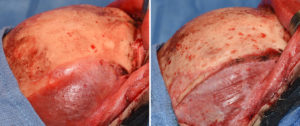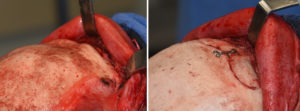Background: Transgender brow bone reduction refers to feminizing the lower central forehead. In the male the frontal sinus air cavity expands more than females and is seen as the outer covering of bone expands creating a set of central paired brow bone prominences that stick out further than the flatter forehead above it. These expanded bony prominences are the target of reduction in either transgender male to female patients or in men with excessively brow bone overgrowth, the difference being in the amount of setback done.
While reduction of the bony brow bones over the frontal sinus alone may be sufficient in male brow bone reduction, it often is not in the transgender patient. It is important to remember that the part of the brow bones that overlie the frontal sinus, better described as the pneumatized brow bone area, makes up only half of the entire length of the brow bones. The part of the brow bone that lies lateral to the pupillary line axis is the solid brow bone part and extends around the eye to connect with the lateral orbital rims. In men the lateral brow bone area has more projection so its reduction should not be overlooked and can be done by a burring technique only.
The brow bones make up about one-third of the total exposed forehead. So it is also important to consider its reshaping as well. The male forehead is broader and often flatter so changing its shape with the brow bone reduction can have a ore complete forehead feminization effect.
Case Study: This transgender patient presented for brow bone reduction. The forehead was fairly broad and flat with a more retroclined slope to it in profile. As a result a comprehensive approach was taken for her forehead feminization urning surgery.




Case Highlights:
1) The foundational procedure in transgender male to female brow bone reduction is the set back of the expanded frontal sinus bone.
2) Setting the bone flap back into the frontal sinus requires a combnation of bone flap thinning and contouring of the interseptal wall and surrounding bony rim of the exposed frontal sinus.
3) Adjunctive forehead procedures include lateral brow bone reduction/reshaping, forehead width reduction and convex upper forehead augmentation.
Dr. Barry Eppley
Indianapolis, Indiana








